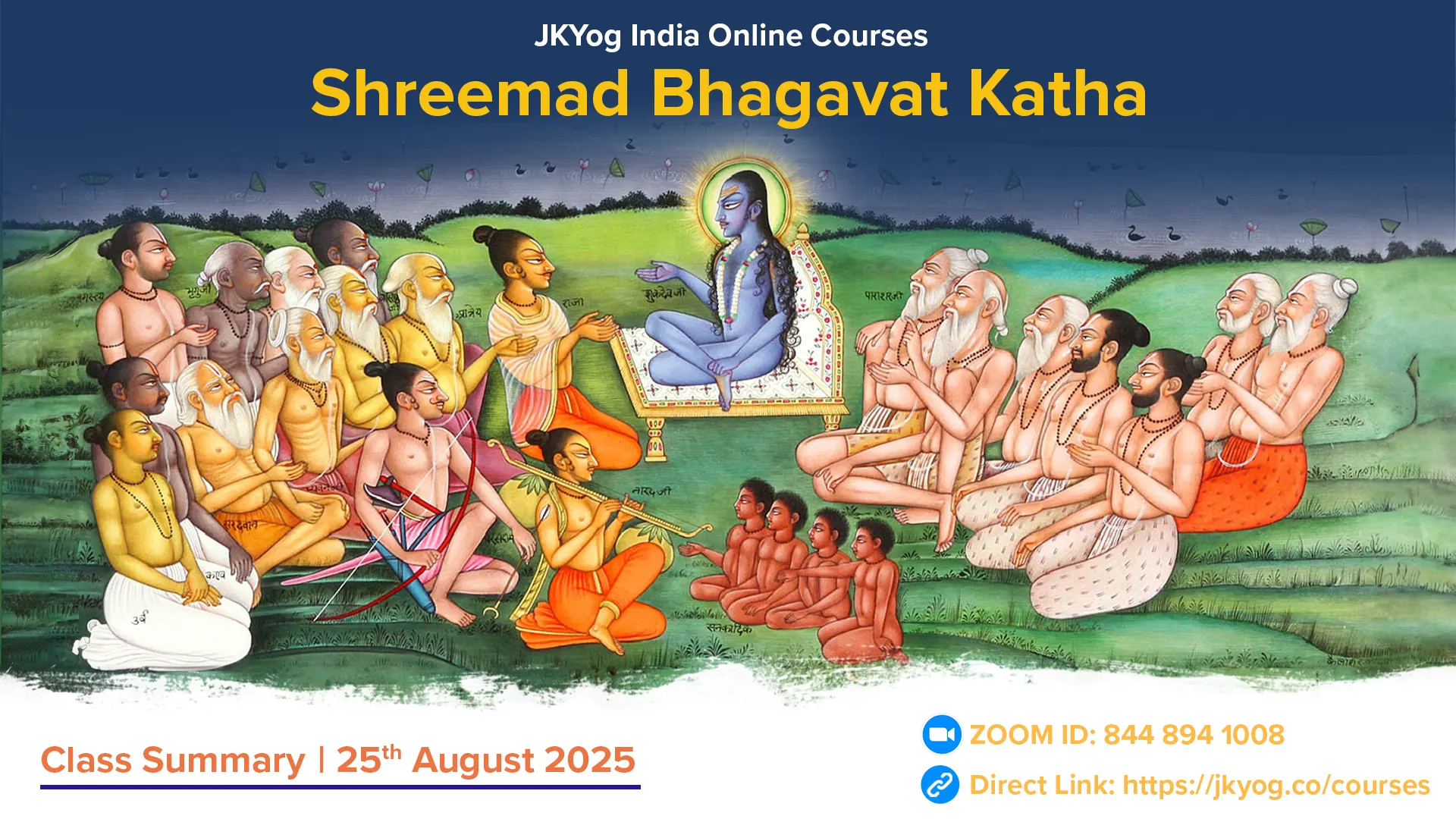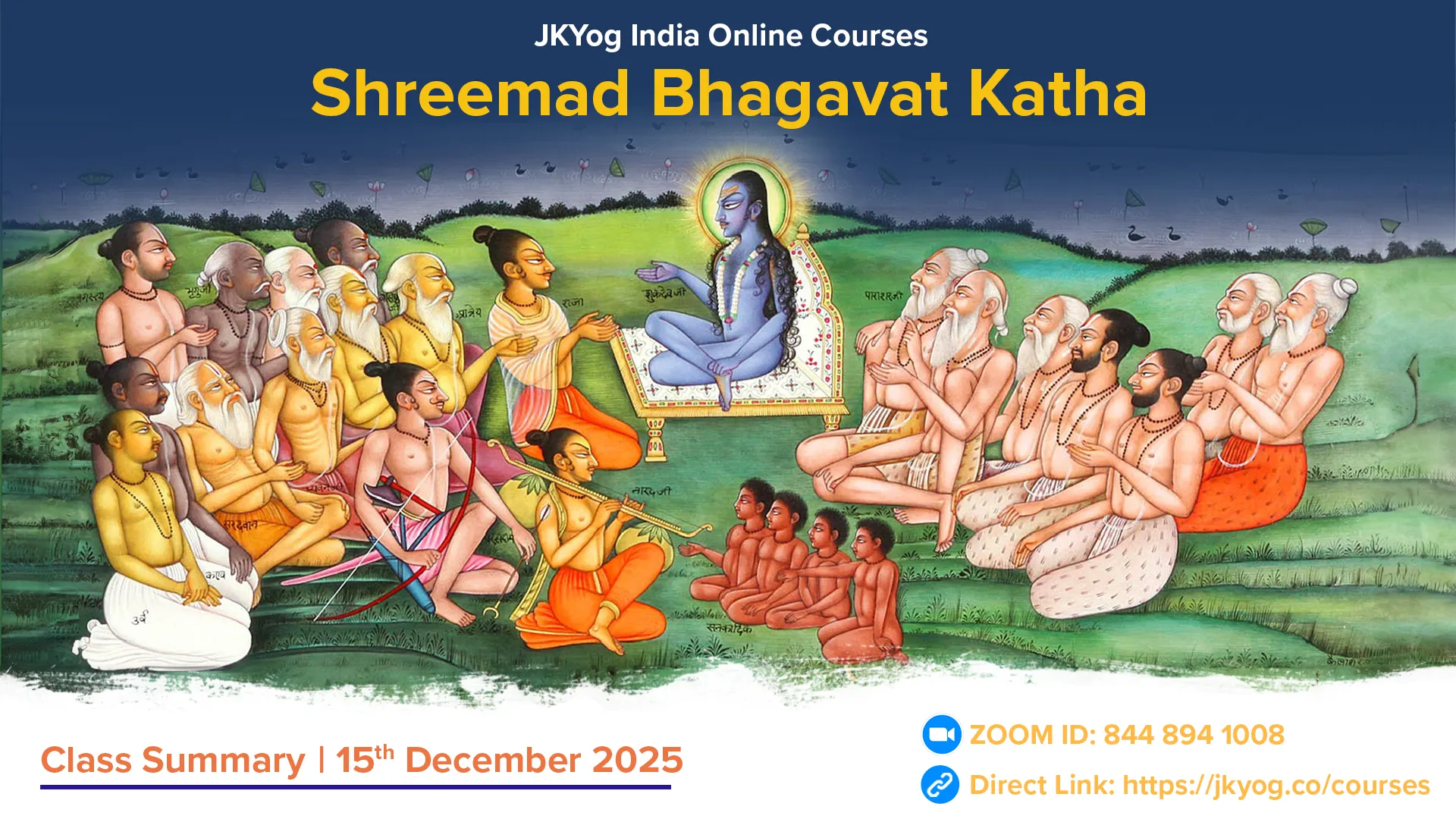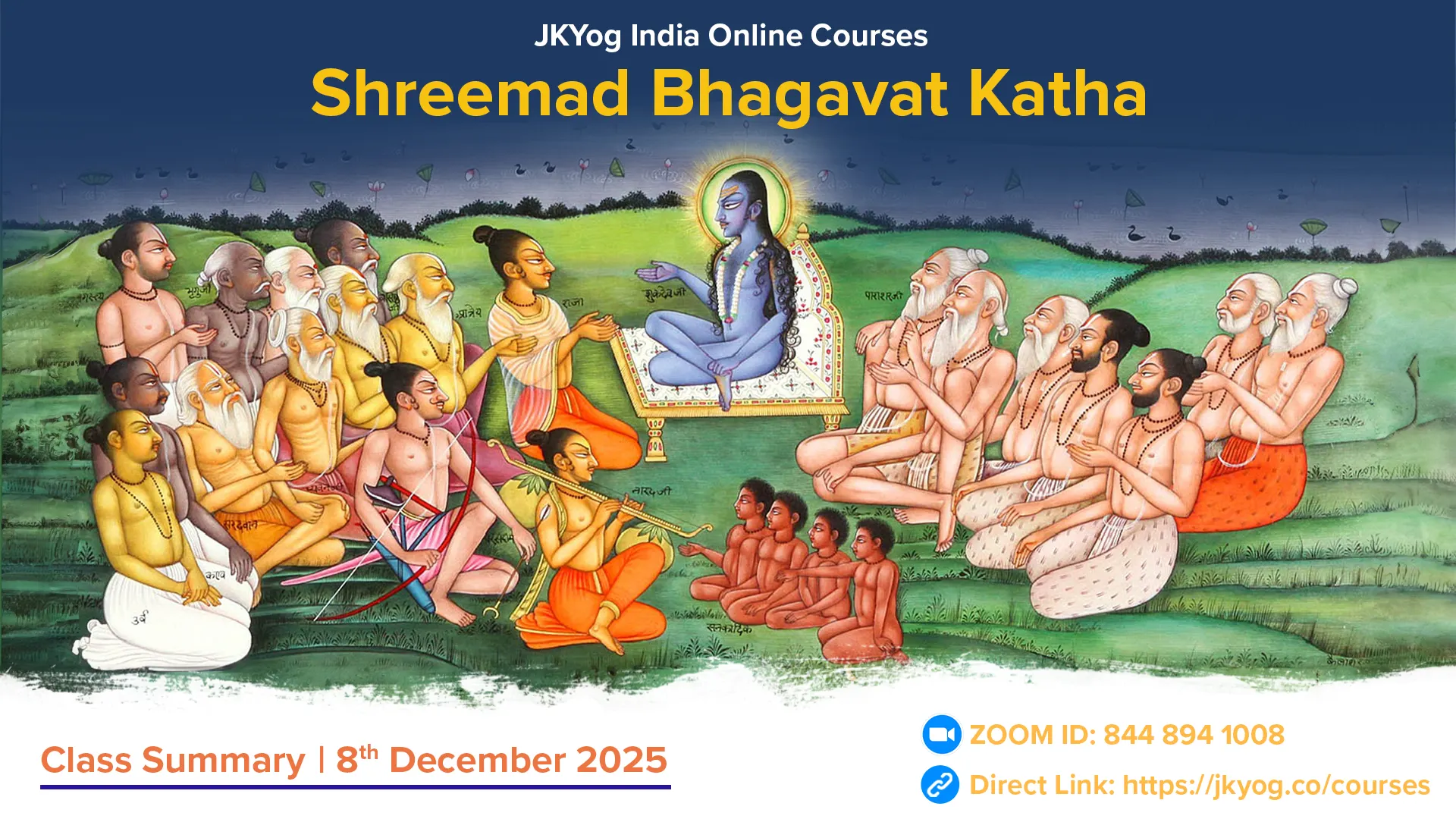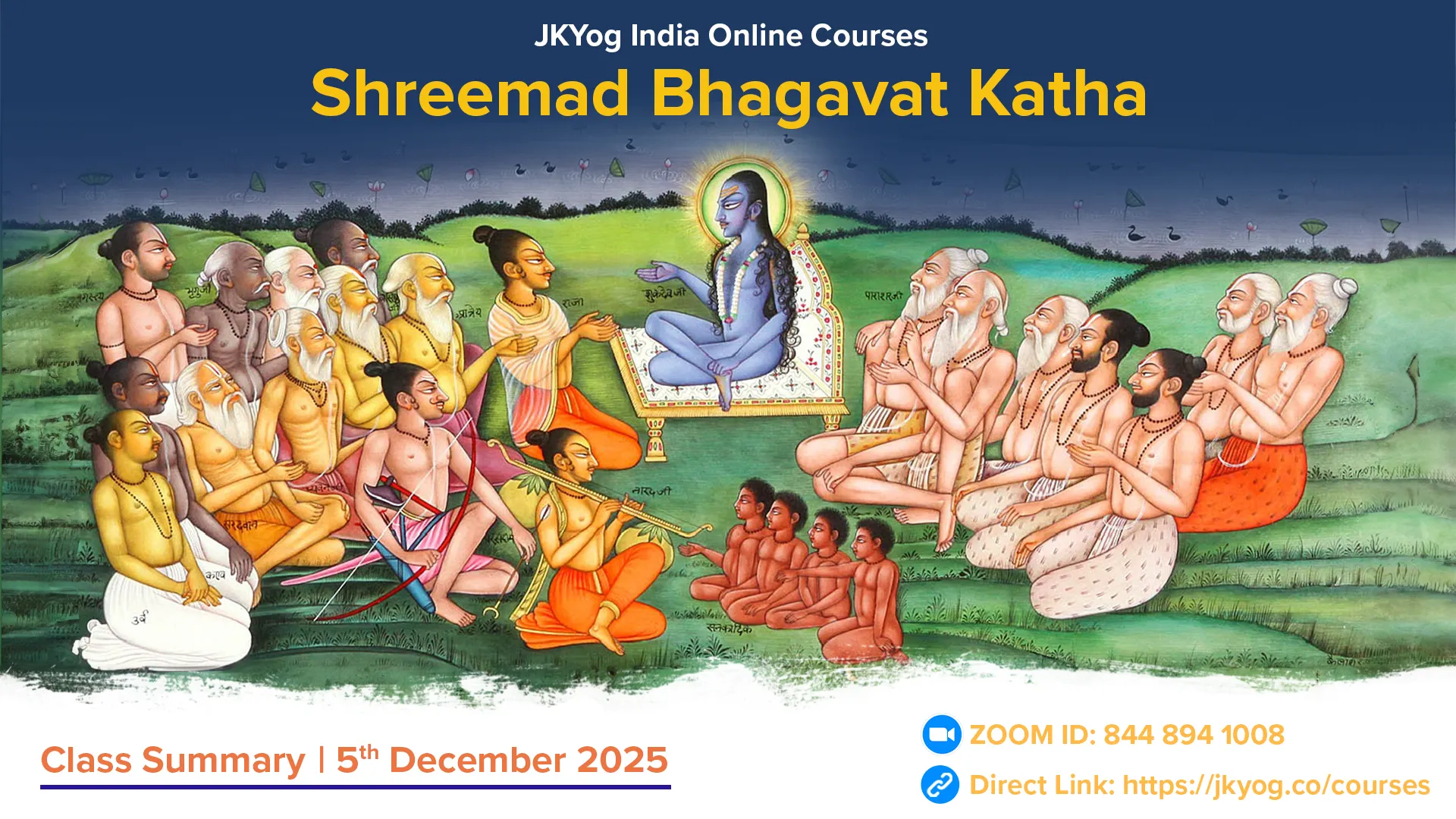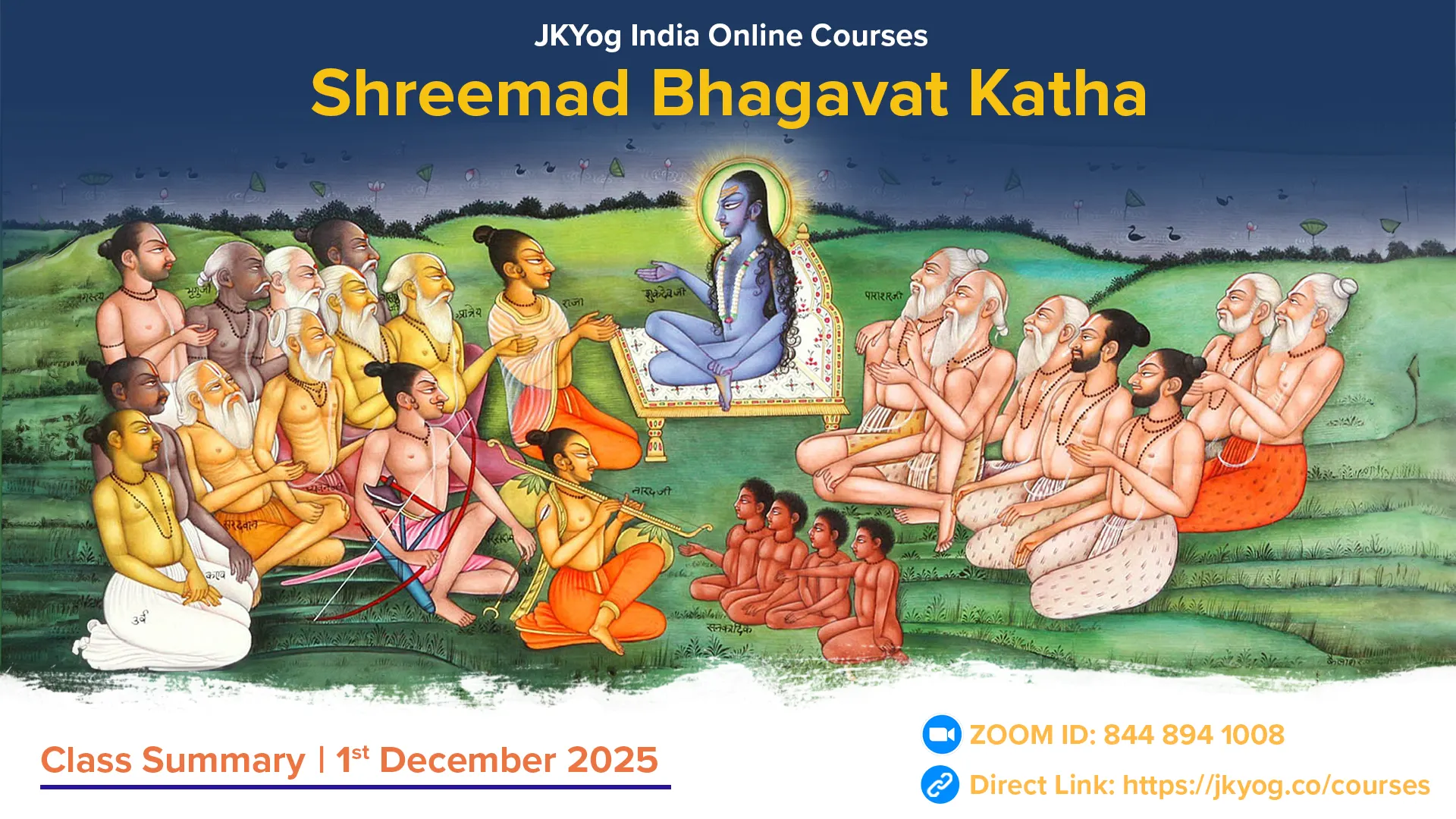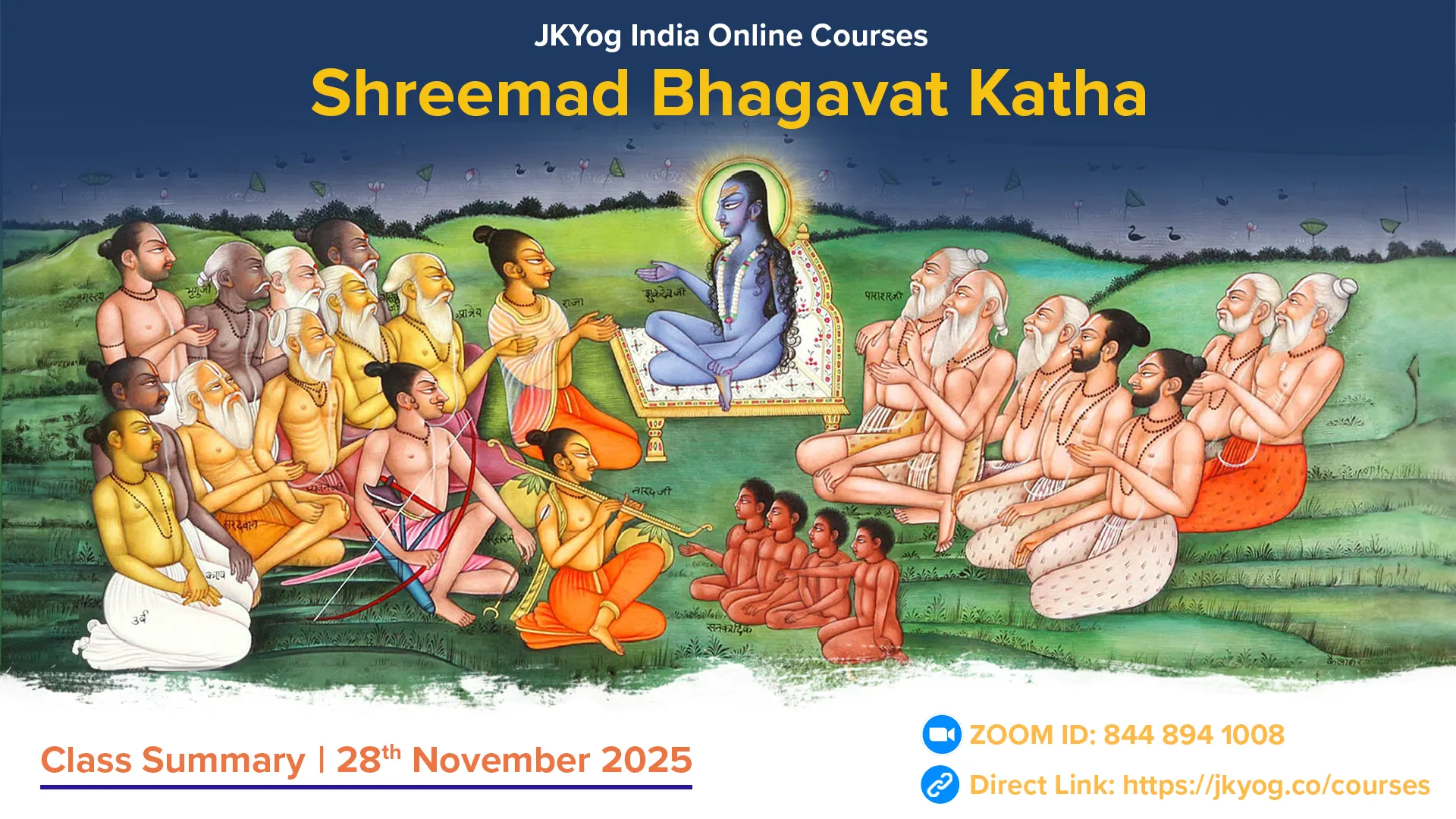Shreemad Bhagavat Mahapuran- Canto: 9, Chapters: 11-14
Shree Shukadevji, narrating to Parikshit about the later pastimes of Shree Ram, says that Bhagwan Ram appointed His guru, Vashishthaji, as the presiding Acharya and organised many yajnas. In these yajnas, He Himself became the yajman (sacrificer) and worshipped His Own Yajna Purusha form.
He assigned the hota to the east, Brahma to the south, the adhvaryu to the west, and the udgata to the north. The remaining portion of land He offered to the Acharya. In this way, He donated the entire earth, keeping only the clothes and ornaments upon His body. Similarly, Sitaji was left only with her auspicious garments and ornaments.
When the brahmins saw that Shree Ram regarded them as His chosen deities, they were immensely pleased. Out of joy, they returned the entire earth to Him and continued to glorify Him.
One night, while Bhagwan Ram was moving secretly through the city to learn of its condition, He overheard a man scolding his wife, “You wicked woman! You have gone to another man’s house. Lustful Ram may have accepted Sita, but I will never keep you in my home.”
When Shree Ram heard such remarks repeated by several people, He grew concerned about public reproach. Out of respect for popular sentiment, He abandoned Janakiji. Sitaji went to reside in the hermitage of Valmiki Muni. At that time, She was pregnant, and in due course, She gave birth to two sons—Lava and Kush. Their sacraments were performed personally by Valmiki Muni.
Ram’s brothers, too, had children—Lakshman’s sons were Angad and Chitraketu, Bharat’s were Taksha and Pushkal, and Shatrughna’s were Subahu and Shrutsen. Bharat defeated the gandharvas and offered their wealth to Ram. Shatrughna killed the rakshas named Lavana and established the city of Mathura.
In time, Janakiji entrusted Her sons to the protection of Valmiki Muni, and Herself merged into the lap of Mother Earth. When Ram received this news, He was deeply overcome with sorrow. Though unsurpassed in wisdom and strength, the remembrance of Sitaji’s pure virtues filled His heart with grief.
Afterwards, He adopted strict brahmacharya (celibacy) and performed many yajnas for thirteen thousand years. At the end, installing His lotus feet in the hearts of His devotees, He departed for His supreme abode.
There has been no one as glorious as Bhagwan Ram. At the request of the devas, He incarnated, destroyed the asuras, and upheld Dharma. Building a bridge across the ocean, seeking aid from the Vanars; all this was but His divine pastime, for being all-powerful, He had no need of assistance.
His fame is pure and sacred, destroying all sins. His glory spread so far and wide that even today, sages and seers sing of His divine character, and the devas remain in the service of His lotus feet. I, too, take refuge in that crest-jewel of the Raghu dynasty, Shree Ram.
Those who had the good fortune of beholding Him directly, living near Him, or following Him—all of them, along with the residents of Koshal, attained the same supreme abode where yogis reach through their disciplines. One who listens to His sacred pastimes awakens within himself divine qualities of simplicity, tenderness, and purity. Not only this, he becomes free from the bondage of Karm and becomes a recipient of Bhagwan’s grace.
Lineage of Shree Ram's Son Kush
Shukadevji, speaking to Parikshit, says that after Bhagwan Ram, the lineage continued through His son Kush. Kush’s son was Atithi, then came Nishadha, followed by Nabha, Pundarika, Kshemdhanva, Devanika, Aniha, Pariyatra, Balsathala, and then Vajranabha (who was a partial incarnation of the Sun god).
From Vajranabha was born Khagan, then Vidhriti, and then Hiranyanabha. Hiranyanabha was a great master of Yog. He was a disciple of Rishi Jaimini, and even Rishi Yajnavalkya studied the path of Adhyatma Yog under him.
From Hiranyanabha came Pushya, then Dhruvasandhi, Sudarshana, Agnivarna, Shighra, and then Maru. Through Yogic practice, Maru attained extraordinary siddhis (spiritual perfections). Even today, he remains alive in a village called Kalapa, and at the end of Kaliyug, when the Solar dynasty will be destroyed, it is he who will reestablish it.
From Maru came Prasushruta, then Sandhi, Amarshana, Mahosvan, Vishvasaha, Prasenajit, Takshaka, and then Brihadbala. It was this Brihadbala who was slain in the battle of Kurukshetra at the hands of Abhimanyu (your father, O Parikshit).
After Brihadbala, the succession continued: Brihadrana, Urukriya, Vatsavriddha, Prativyoma, Bhanu, Divaka (a great commander), Sahadeva, Brihadashva, Bhanuman, Pratikashva, Supratik, Marudeva, Sunakshatra, Pushkara, Antariksha, Sutapa, Amitrajit, Brihadraja, Barhi, Kritanjaya, Rananjaya, Sanjaya, Shakya, Shuddhoda, Langala, Prasenajit, Kshudraka, Ranaka, Suratha, and Sumitra.
It is said that Sumitra will be the last king of this line. During his reign in Kaliyug, the illustrious Ikshvaku dynasty will come to an end.
King Nimi Becomes Videha by the Curse of Vashishtha
In the great Ikshvaku dynasty, there was a righteous and God-devoted king named Nimi. He was deeply sattvic by nature and immersed in devotion to Bhagwan.
One day, a thought stirred in his heart, “Human life is fleeting, every breath uncertain. Why waste it in worldly pursuits? It must be dedicated to the worship of God and the performance of yajna.”
With this resolve, he decided to conduct a grand yajna and invited the revered sage Vashishtha to be the chief priest (Acharya).
But Vashishtha said, “O King, Indra has already appointed me to preside over his yajna. Once his sacrifice is complete, I shall certainly come. Till then, please wait.”
King Nimi’s heart, however, was restless with another conviction, “Who can trust life? Death may strike at any moment. It is unwise to delay service to Dharma and worship of Bhagwan.”
So without waiting, he invited other sages and commenced the yajna. Some time later, Vashishtha returned only to see the sacrifice already underway without him. Anger flared in him.
“King Nimi is arrogant in his own knowledge,” he thundered, “may this body of his be destroyed!”
The king, calm and composed, replied, “Respected Guru! You, too, have neglected Dharma out of attachment to Indra’s favour. Therefore, your body too shall perish.”
And so, both abandoned their mortal forms. King Nimi, being well-versed in self-realisation, attained supreme peace, while Vashishtha was later reborn in the womb of Urvashi through Mitravaruna.
The sages carefully preserved Nimi’s body. When the yajna concluded, the devas appeared, and the sages prayed, “O devas, if you are pleased, please restore our king to life.”
The devas agreed, but Nimi himself spoke, “I no longer desire a body. This body is but a dwelling of sorrow, grief, and fear. Just as a fish is surrounded by death at every moment, so too is the soul encircled by death as long as it inhabits the body. I only wish to be free and absorbed in remembrance of Bhagwan.”
The devas blessed him, “So be it. From now on, King Nimi will live without a body, residing in the eyelids of all beings. That fleeting moment during the blink of an eye—that is the existence of Nimi.”
Thus, the instant of an eye-blink came to be called “Nimesha”, the time it takes for a man to open and close his eyes.
But the sages worried, “If our king does not return, what will happen to the kingdom? Without a ruler, chaos will spread.”
So they churned the preserved body of King Nimi. From it emerged a radiant boy. The sages named him Janak. Since he was born from Nimi, who had become Videha (bodiless), Janaka too was called Vaideha. And because he was born from the churning (manthana) of a body, he was named Mithil.
This Janak later established the famed city of Mithila.
The Lineage of King Janak
From King Janak was born Udavas, then Nandivardhana, followed by Suketu, Devarata, Brihadratha, Mahavirya, Sudhriti, Dhrishtaketu, Haryashva, Maru, Pratipaka, Kritiratha, Devamidha, Vishruta, Mahadhuti, Kritirat, Maharoma, Swarna-roma, and Hrasvaroma.
From Hrasvaroma was born the illustrious Siradhvaja. While ploughing the earth as part of a yajna, the tip of his plough struck the soil and from it emerged Sitaji.
Siradhvaja’s son was Kushadhvaja. From him came Dharmadhvaja, who had two sons—Kritadhvaja and Mitadhvaja. From Kritadhvaja was born Keshidhvaja, and from Mitadhvaja came Khandikya. Keshidhvaja was deeply versed in the knowledge of the Self (Atmavidya), while Khandikya excelled in ritualistic practices (Karmakanda). Fearing Keshidhvaja’s spiritual superiority, Khandikya withdrew and went away.
From Keshidhvaja the line continued: Bhanuman, Shatadyumna, Shuchi, Sanadvaja, Urdhvaketu, Aja, Purujit, Arishtanemi, Shrutayu, Suparshva, Chitraratha, Kshemadhi, Samartha, Satyaratha, Upaguru, Upagupta (a partial incarnation of Agni), Vasvananta, Yuyudha, Subhashana, Shruta, Jaya, Vijaya, Rita, Shunaka, Vitahavya, Dhriti, Bahulashva, Kriti, and finally Mahavashi.
The Abduction of Tara by Chandra and the Birth of Budha
Shree Shukadevji narrates to Parikshit the story of the lunar dynasty (Chandra Vansh), a lineage so illustrious that radiant kings like Pururava were born in it.
Brahmaji had a son named Atri Rishi. So virtuous and luminous was he that people, upon seeing him, often mistook him for Brahma himself. From the divine radiance that flowed out of Atri’s eyes was born Chandra (the Moon-god).
Brahmaji appointed Chandra as the lord of the brahmins, herbs, and constellations (nakshatras).
Gradually, Chandra acquired immense power and splendour. He conquered the three worlds and even performed the mighty Rajasuya Yajna. But with success came pride. Intoxicated with arrogance, he abducted Tara, the wife of Deva-guru Brihaspati.
Brihaspati pleaded again and again, “O Chandra, return my wife to me!”
But blinded by ego, Chandra did not listen. This led to a ferocious battle between the devas and the asuras. Shukracharya sided with the asuras, while Mahadevji supported his guru, Brihaspati. The clash was so fierce, it seemed as if the cosmos itself was being consumed in dissolution.
At that moment, Angira Rishi approached Brahmaji, urging him to intervene and stop the devastation. Brahmaji rebuked Chandra and restored Tara to her rightful husband, Brihaspati.
But by then, Tara was pregnant. In anger, Brihaspati declared, “This child is not mine—cast him away!”
Ashamed, Tara gave birth to a radiant boy, glowing like molten gold. Both Chandra and Brihaspati were captivated by the child’s brilliance, and each claimed, “This son is mine!”
When everyone pressed Tara to reveal the truth, she remained silent out of shame. At last, the boy himself, angered, said to his mother, “Mother! Do not speak falsehood. Tell me truly—whose son am I?”
Finally, Brahmaji counselled Tara, and she admitted, “This is indeed the son of Chandra.”
Brahmaji then named the child Budha. From Budha was born the mighty king Pururava, who carried forward the glory of the Chandra Vansh.
The Story of Pururava and Urvashi
Once, in the court of Indra, Naradji was praising King Pururava. He said, “Pururava is not only valiant but also handsome and generous.”
Hearing these words, the heart of the apsara Urvashi was stirred. Moreover, because of a curse from Mitravaruna, she was destined to descend to earth.
When Urvashi appeared before Pururava, the king’s eyes lit up with delight. He welcomed her warmly, “Beautiful one, you are most welcome. Sit here—tell me, how may I serve you? Come, be with me, let our union endure forever.”
Urvashi smiled and said, “O King, which woman would not be enchanted by your form? I, too, wish to be with you, but on three conditions:
- First, you must guard the two lambs entrusted to me.
- Second—I will eat only ghee.
- Third—apart from our intimacy, you must never appear before me in a naked state.”
The king eagerly agreed. From then on, the two roamed together in gardens like Nandanvan and Chaitrarath, laughing, playing, and loving each other. The fragrance of lotuses emanated from Urvashi’s body, intoxicating the king.
But Indra grew restless without Urvashi. He sent gandharvas to bring her back. One night, the gandharvas came and stole the two lambs.
When Urvashi heard the bleating of her lambs, she flared up and taunted Pururava, “See this great hero! He cannot even protect my lambs. In the day, he boasts of bravery, but at night, he sleeps like a helpless woman!”
These harsh words pierced Pururava’s heart. He rushed out with his sword, unclothed in his haste, and rescued the lambs. But in that moment of light, Urvashi saw him naked. Bound by her vow, she left him at once.
Pururava was devastated, mad with longing. He wandered everywhere searching for her. Once, on the banks of the Saraswati River, he saw Urvashi with her companions. He pleaded, “Beloved, do not abandon me! Stay for just a moment—without you, my life is worthless.”
Urvashi sighed and replied, “O King, do not waste away in sorrow. Know this—women are never constant companions. Their nature is fickle and merciless. At the slightest offence, they flare up, and for their own pleasure, they may do anything. Be patient, you are a king. Do not lose dignity. I will grant you this—once a year, for one night, I shall be with you, and you will have children through me.”
Pururava noticed she was already with child. He returned to his capital. A year later, when he came again, she had given birth to a valiant son.
Their meeting gave Pururava great joy, though it lasted only a night. At dawn, when it was time for farewell, he was overcome with grief. Then Urvashi said, “Offer praises to the gandharvas. If they are pleased, they may grant me to you.”
Pururava sang hymns to the gandharvas. Pleased, they gave him a vessel for kindling fire (agnisthali). Thinking it to be Urvashi herself, Pururava embraced it to his chest and wandered through the forests.
When he came to his senses, he realised his mistake, left the vessel in the forest, and returned to his palace. Yet his nights were filled only with thoughts of Urvashi.
Time passed, and with the advent of the Treta Yug, the three Vedas were revealed in Pururava’s heart. He went to the spot where he had left the vessel, and found a peepal tree grown there. From its wood, he made two fire sticks (aranis). He imagined the lower arani as Urvashi, the upper arani as himself, and the piece in between as their child.
With mantras, he churned the sticks, and Agni (fire) was born, called Jataveda. Pururava accepted Agni as his son and divided him into three forms—Ahavaniya, Garhapatya, and Dakshinagni. Then, to fulfil Urvashi’s wish, through these three fires, he worshipped Bhagwan Shree Hari, the Lord of all yajnas.
Shree Shukadevji tells Parikshit, “In Satya Yug, there was only one Veda—the Pranava (Om). All scriptures were contained within it. There was only one deva—Narayana. Agni too was one, and society had only one varna—the Hamsa. But from Treta Yug onwards, the Vedas became three, and fire manifested in three forms. Pururava accepted Agni as his own son, and in the end attained Gandharva Loka.”
Summary: JKYog India Online Class- Shreemad Bhagavat Katha [Hindi]- 25.08.2025

